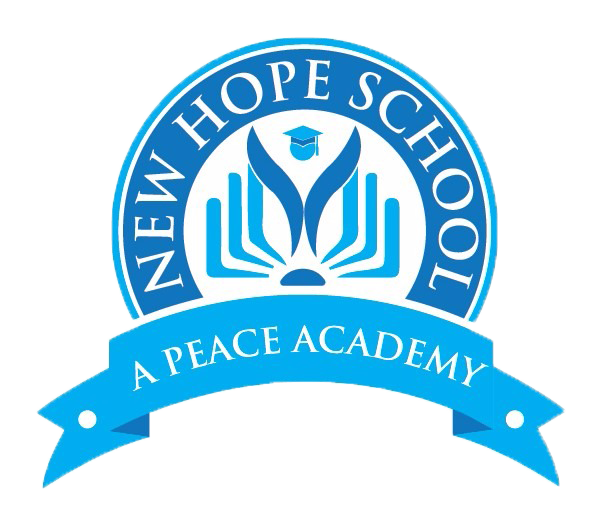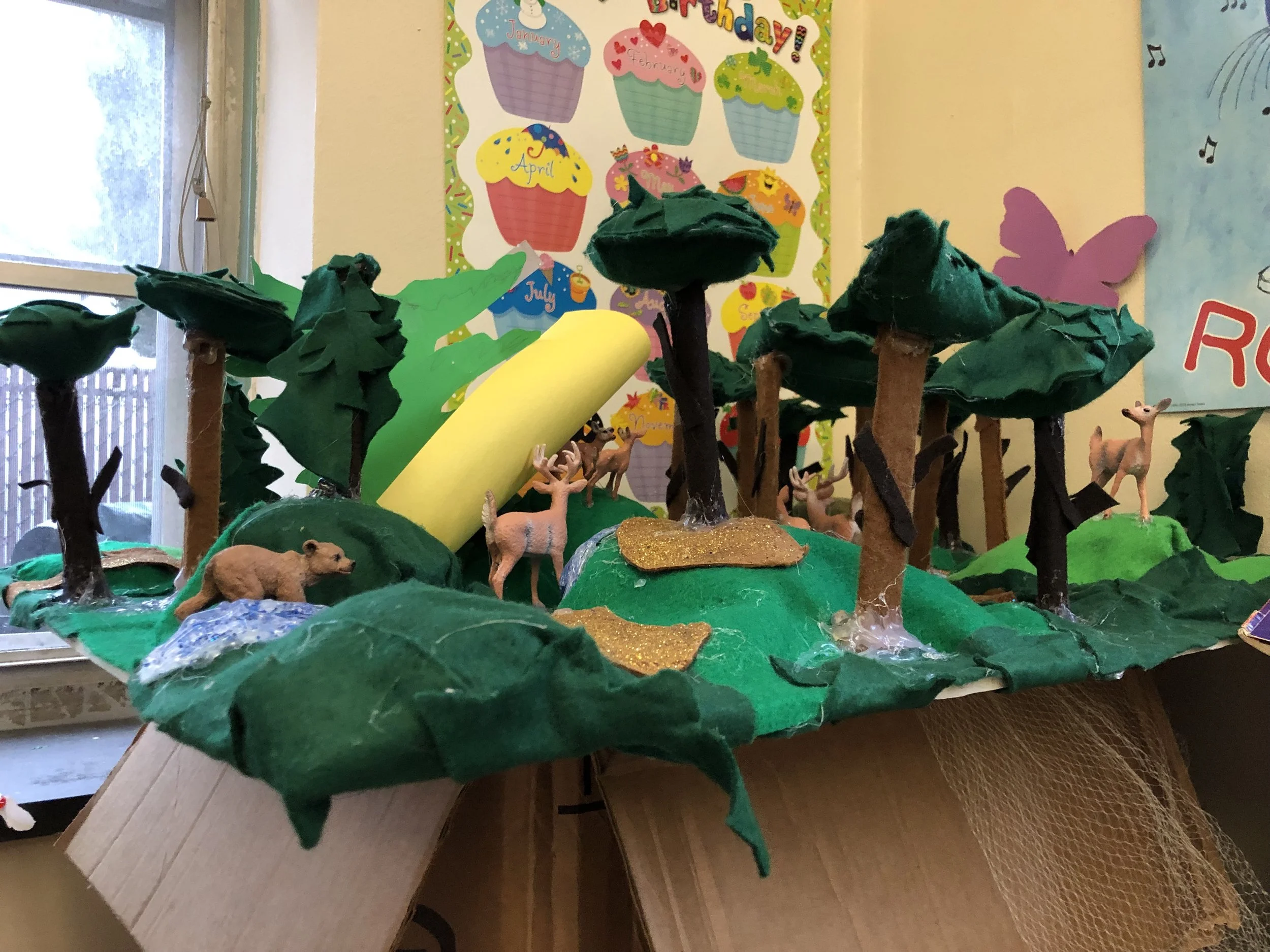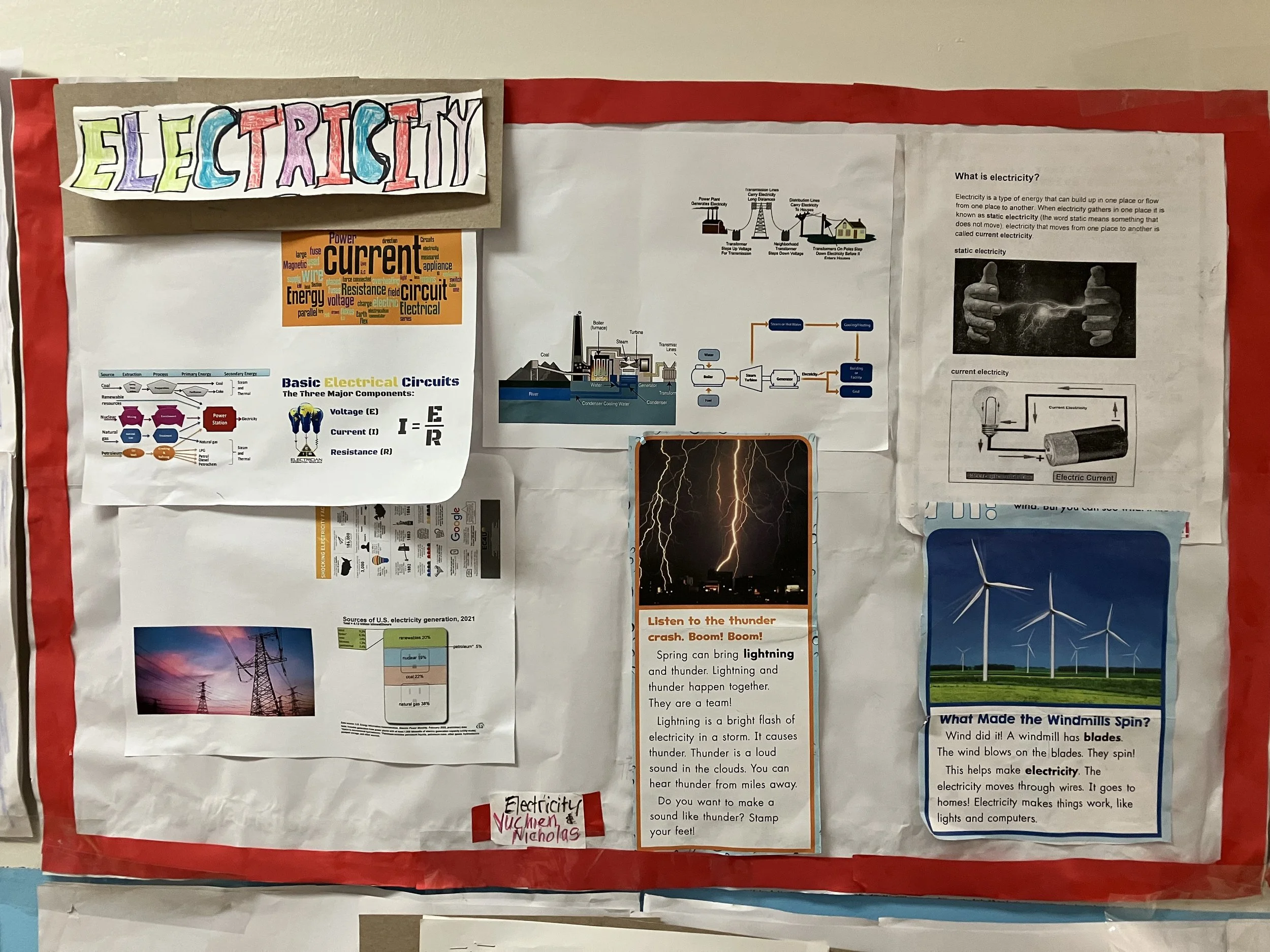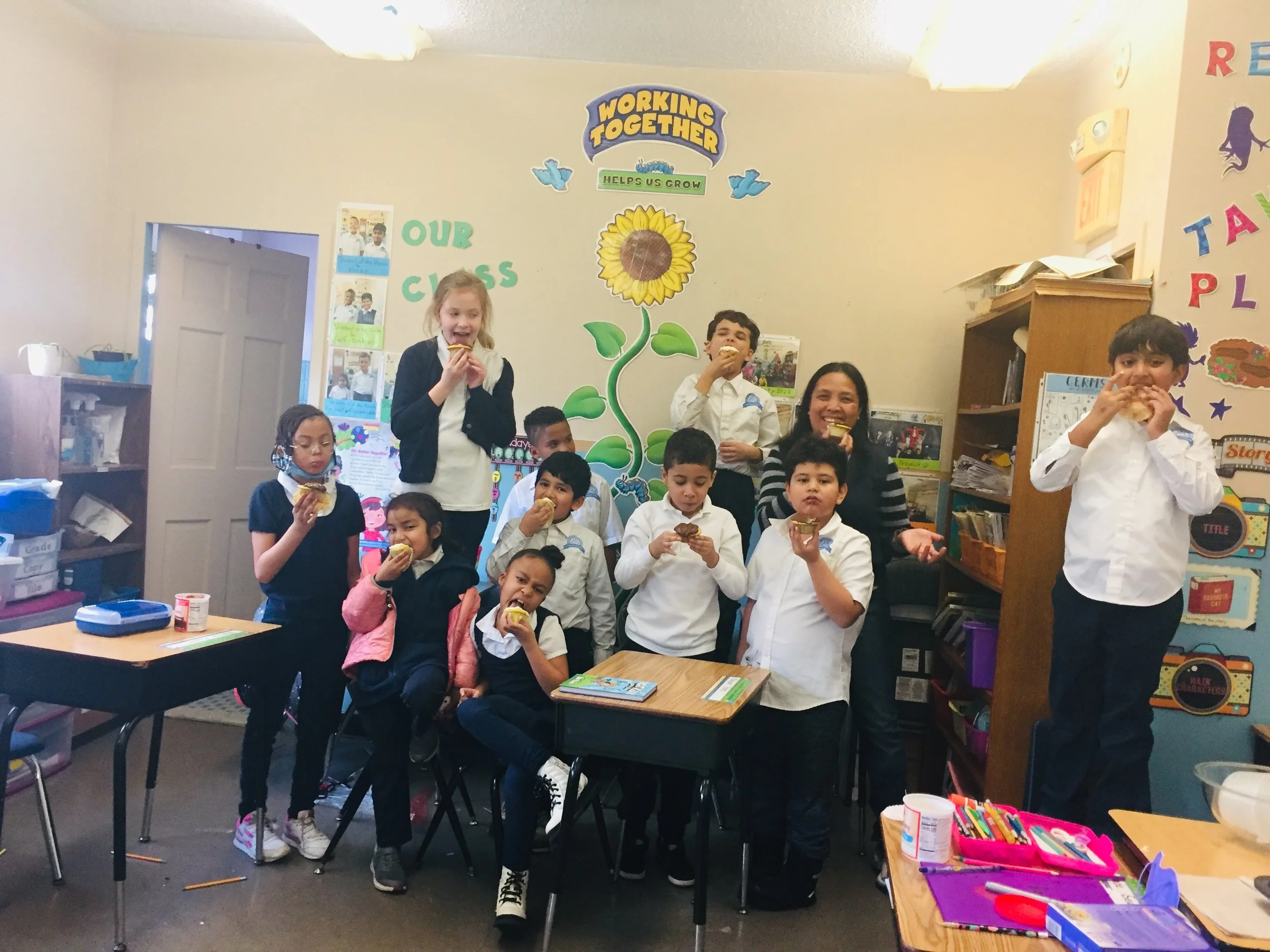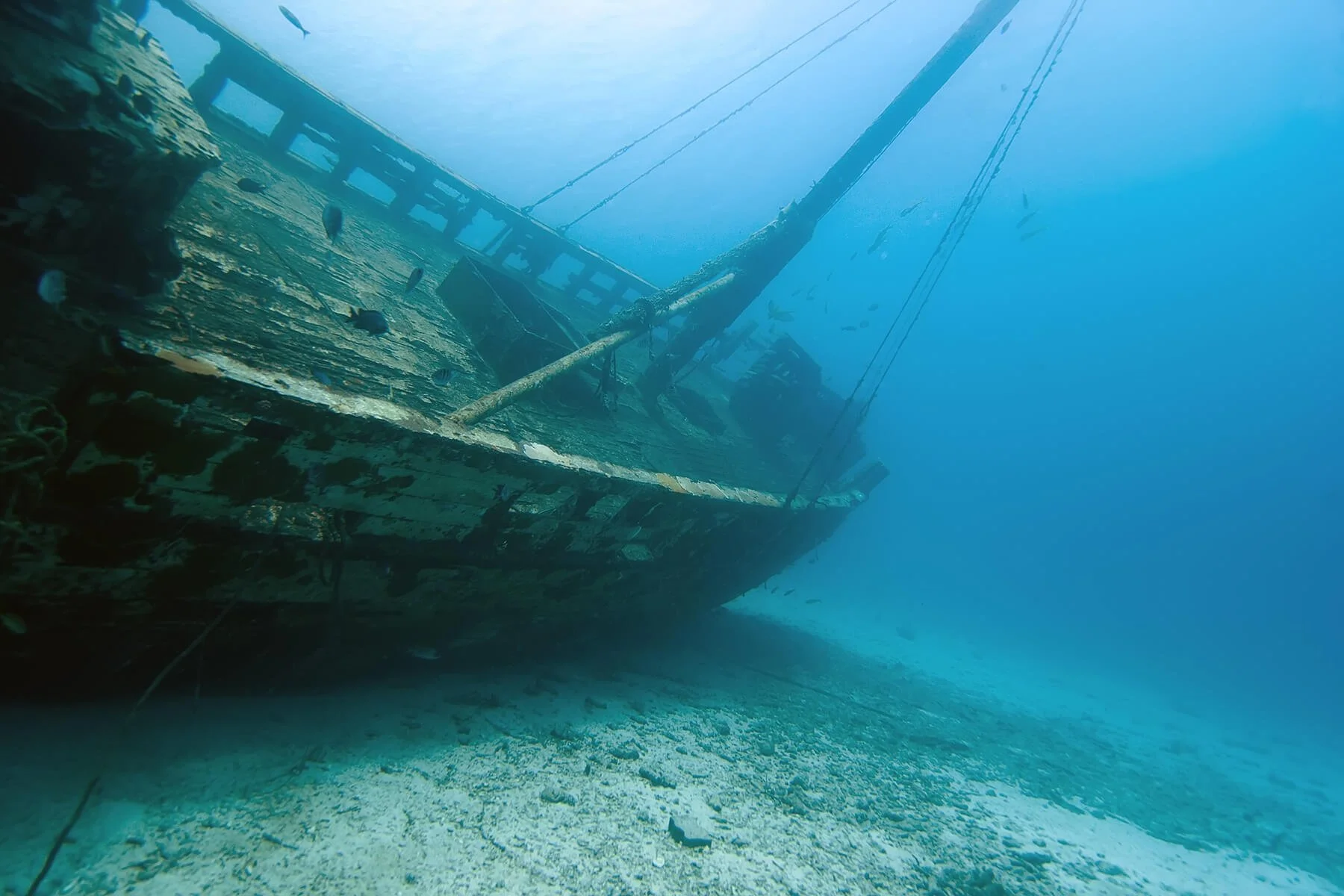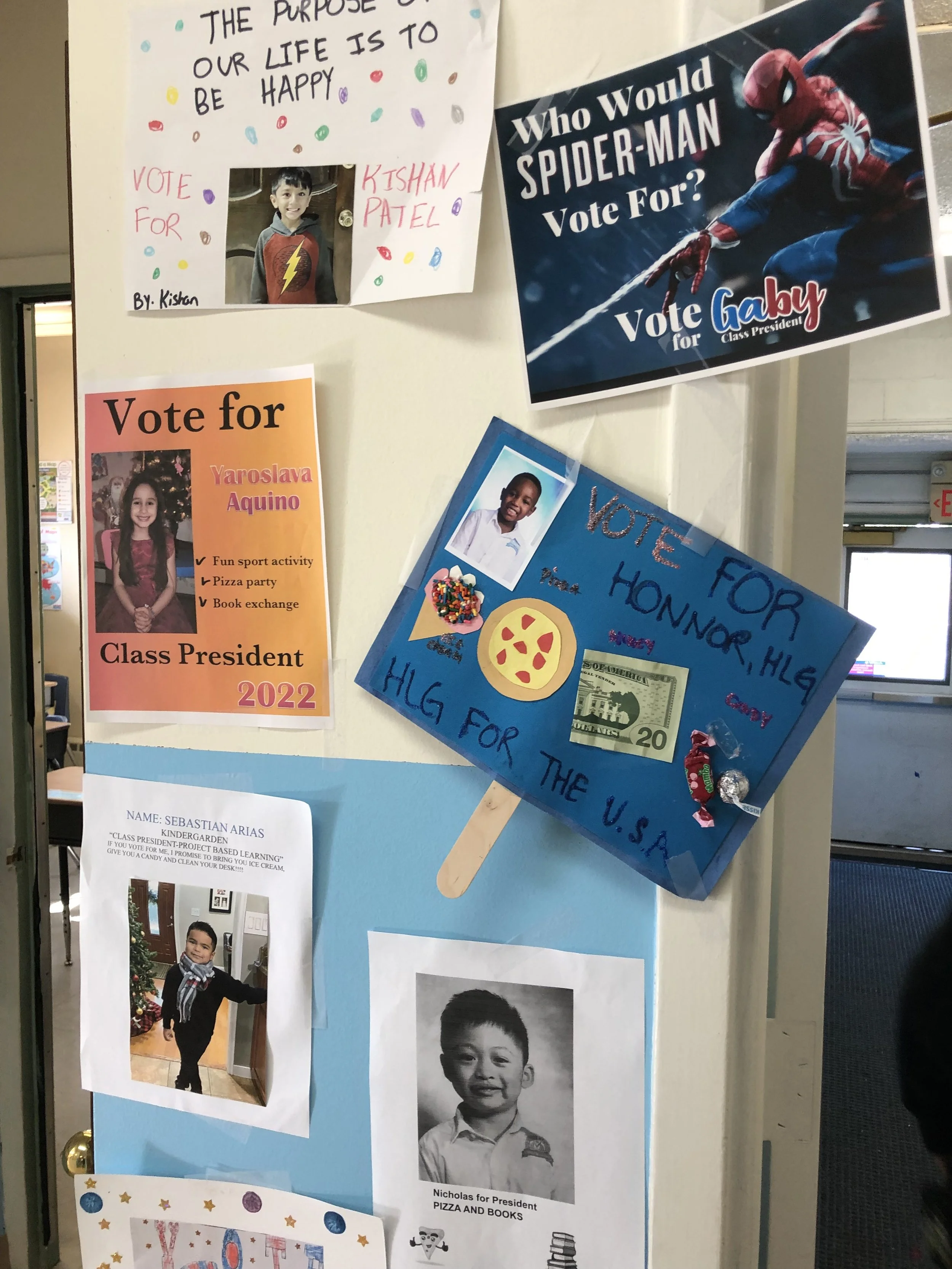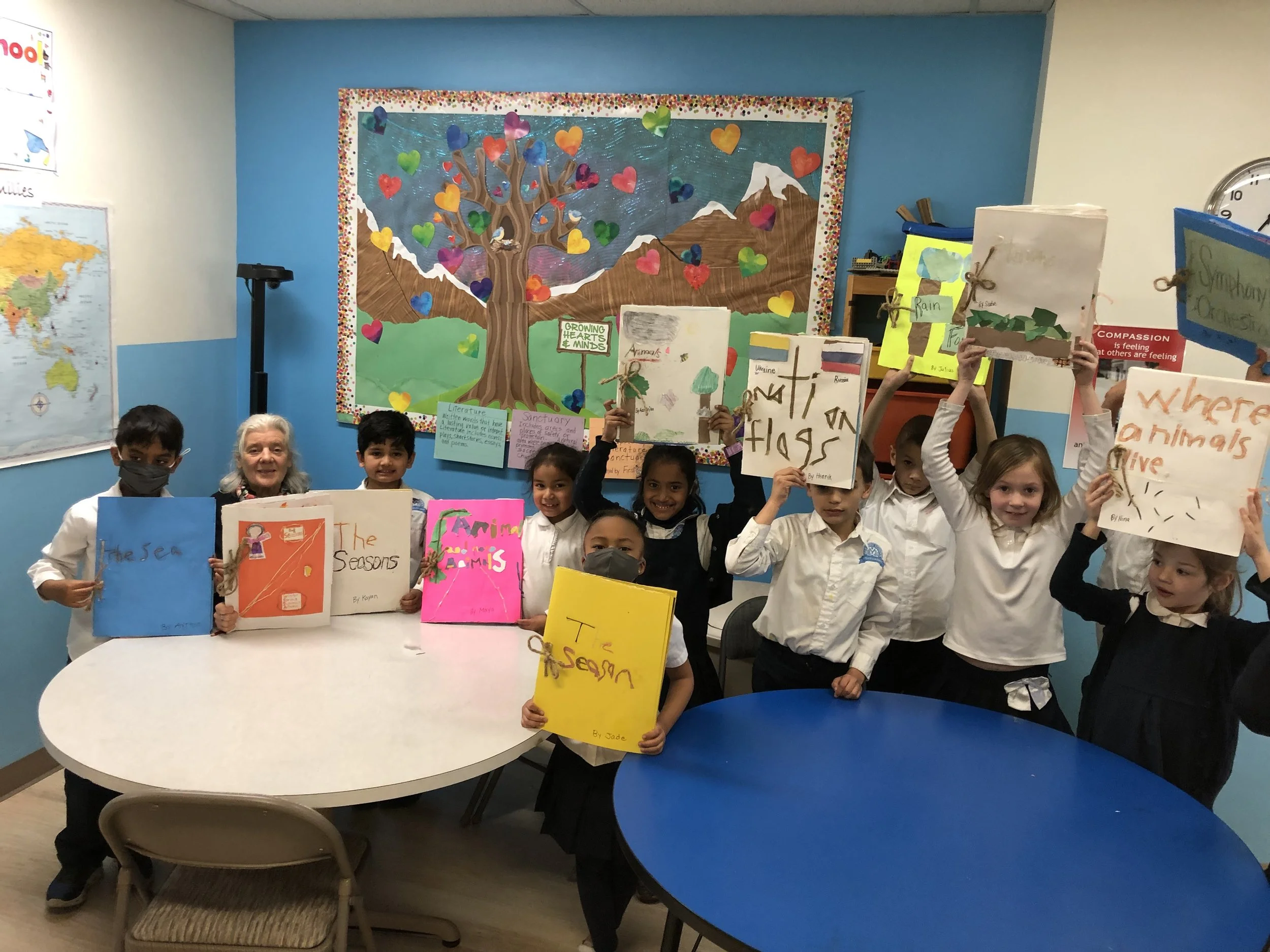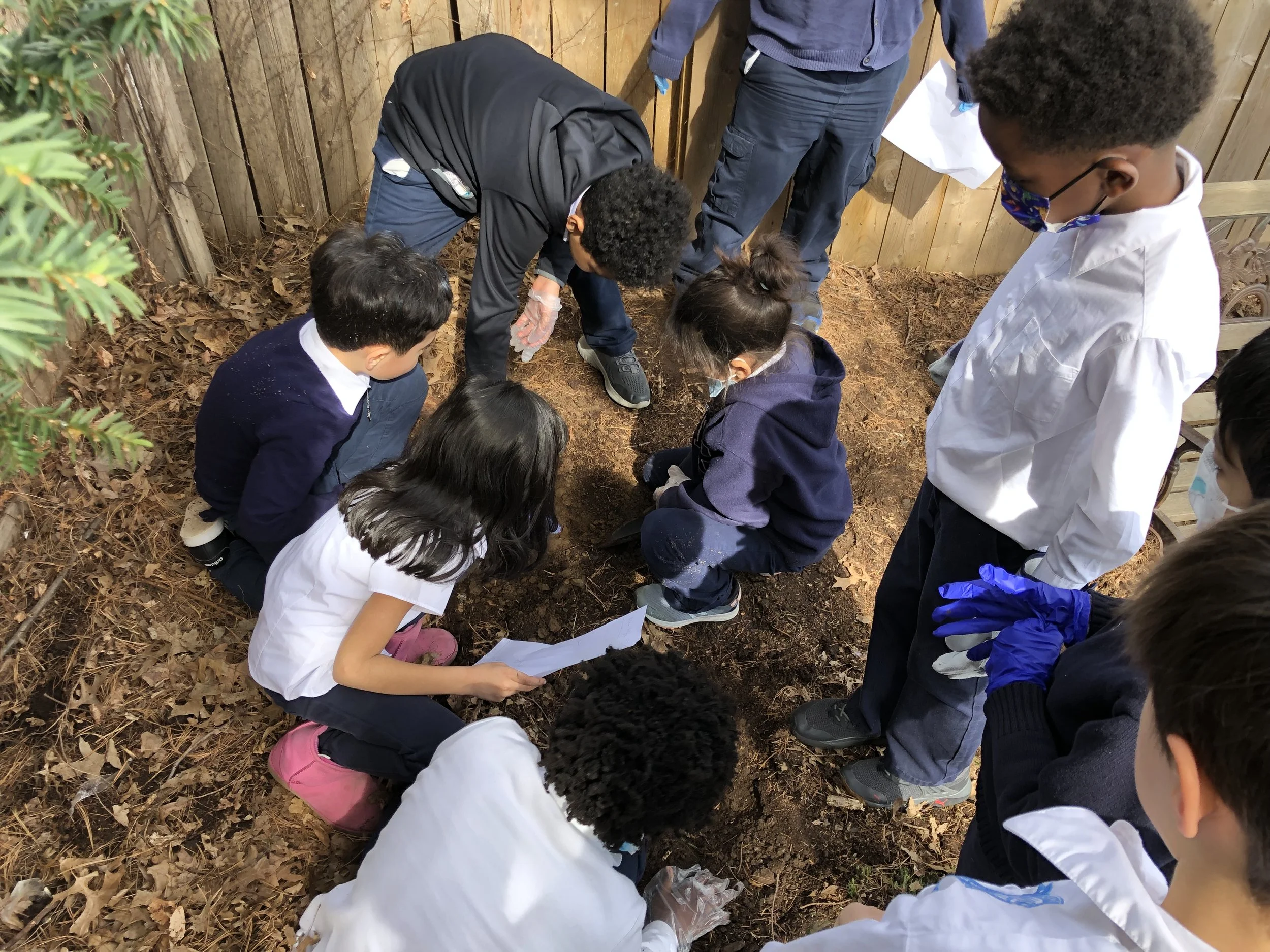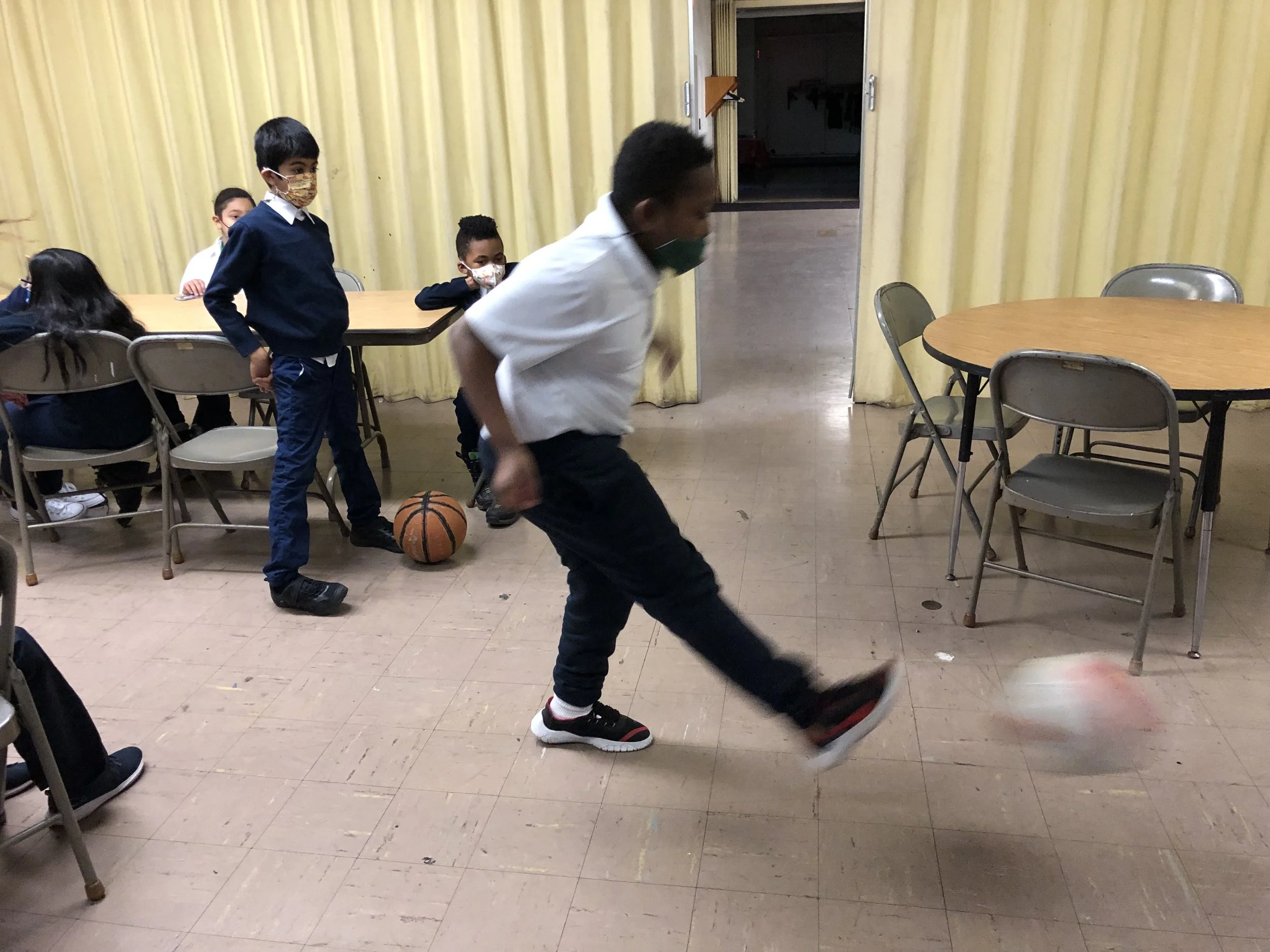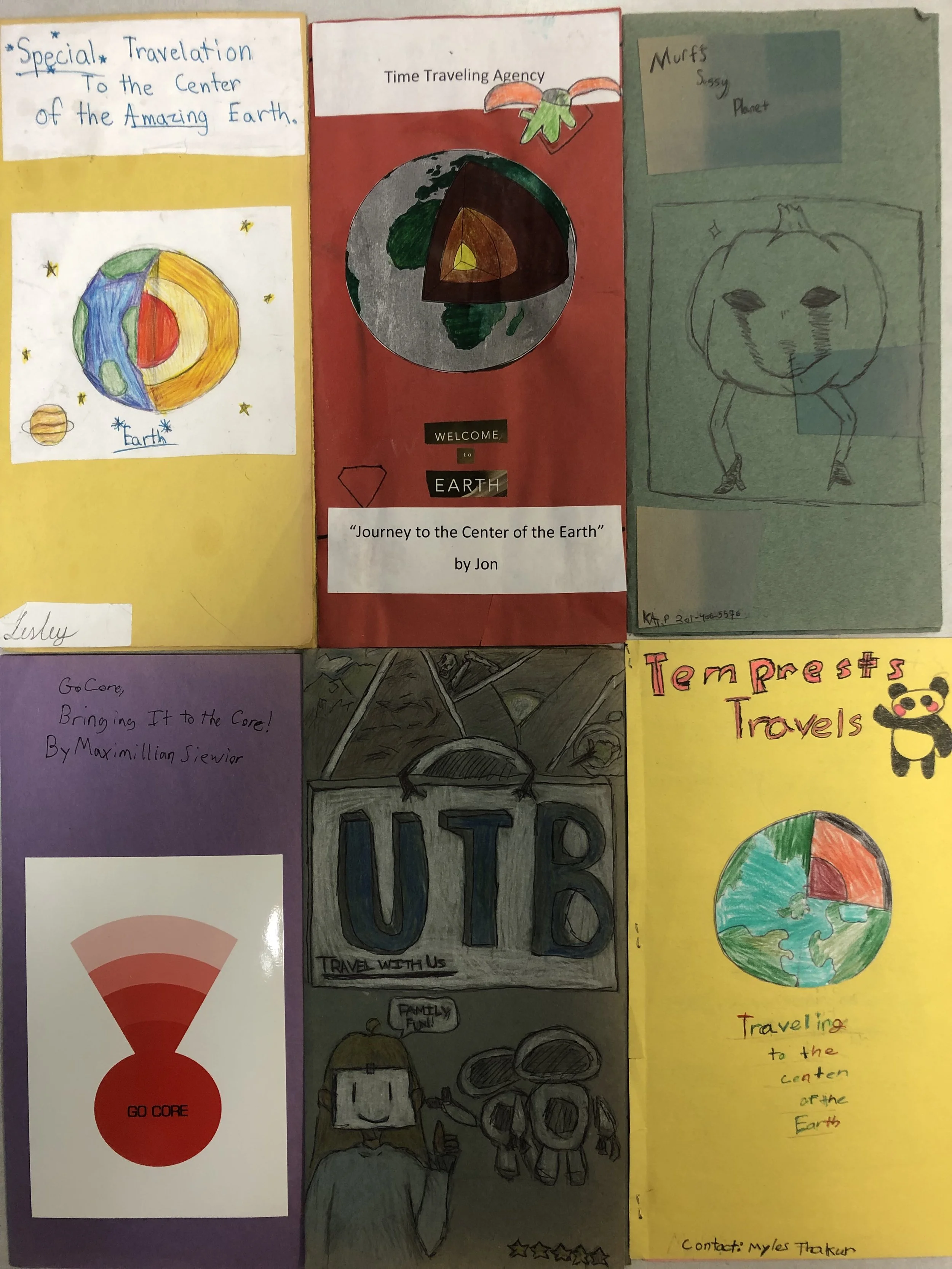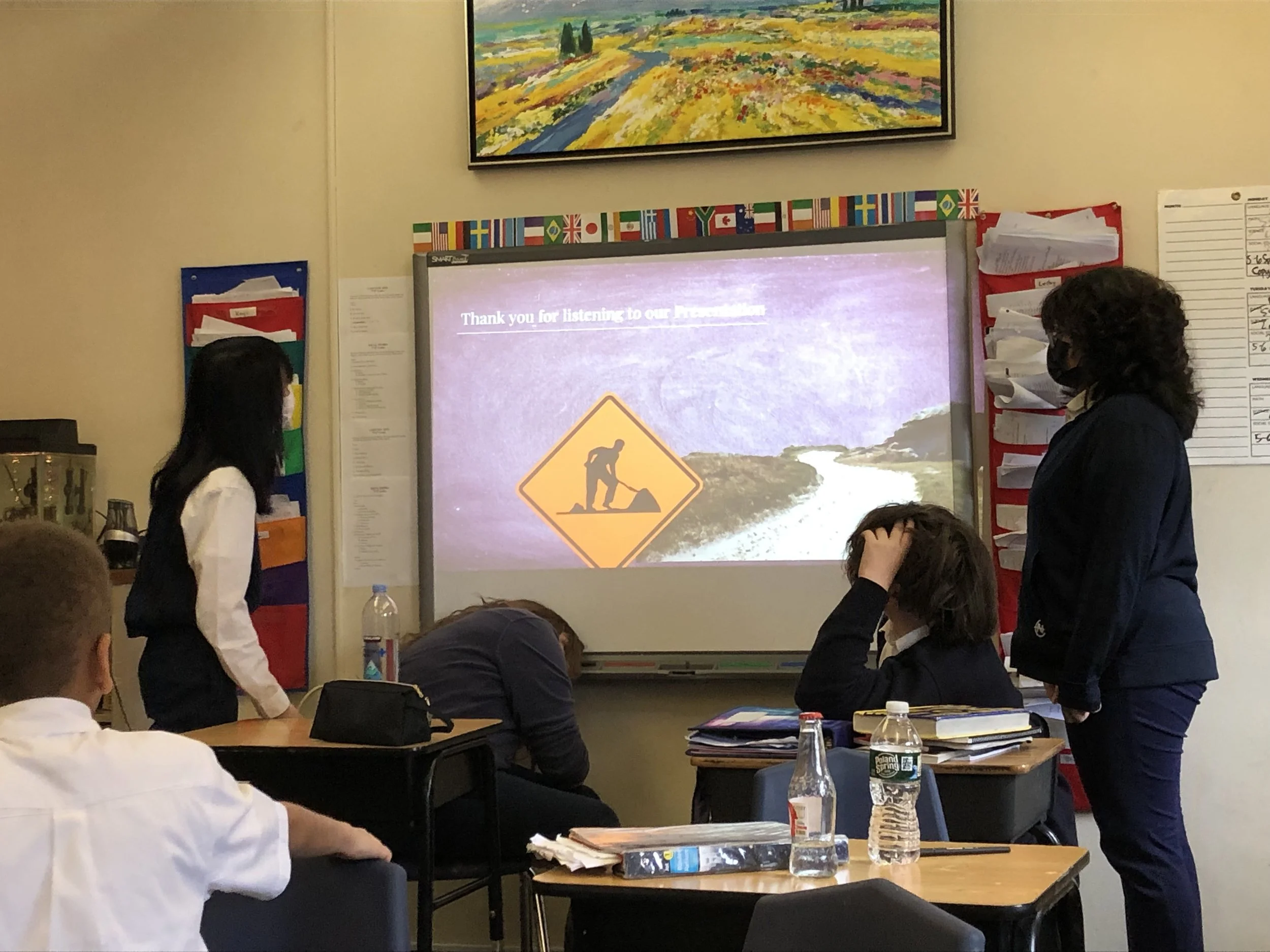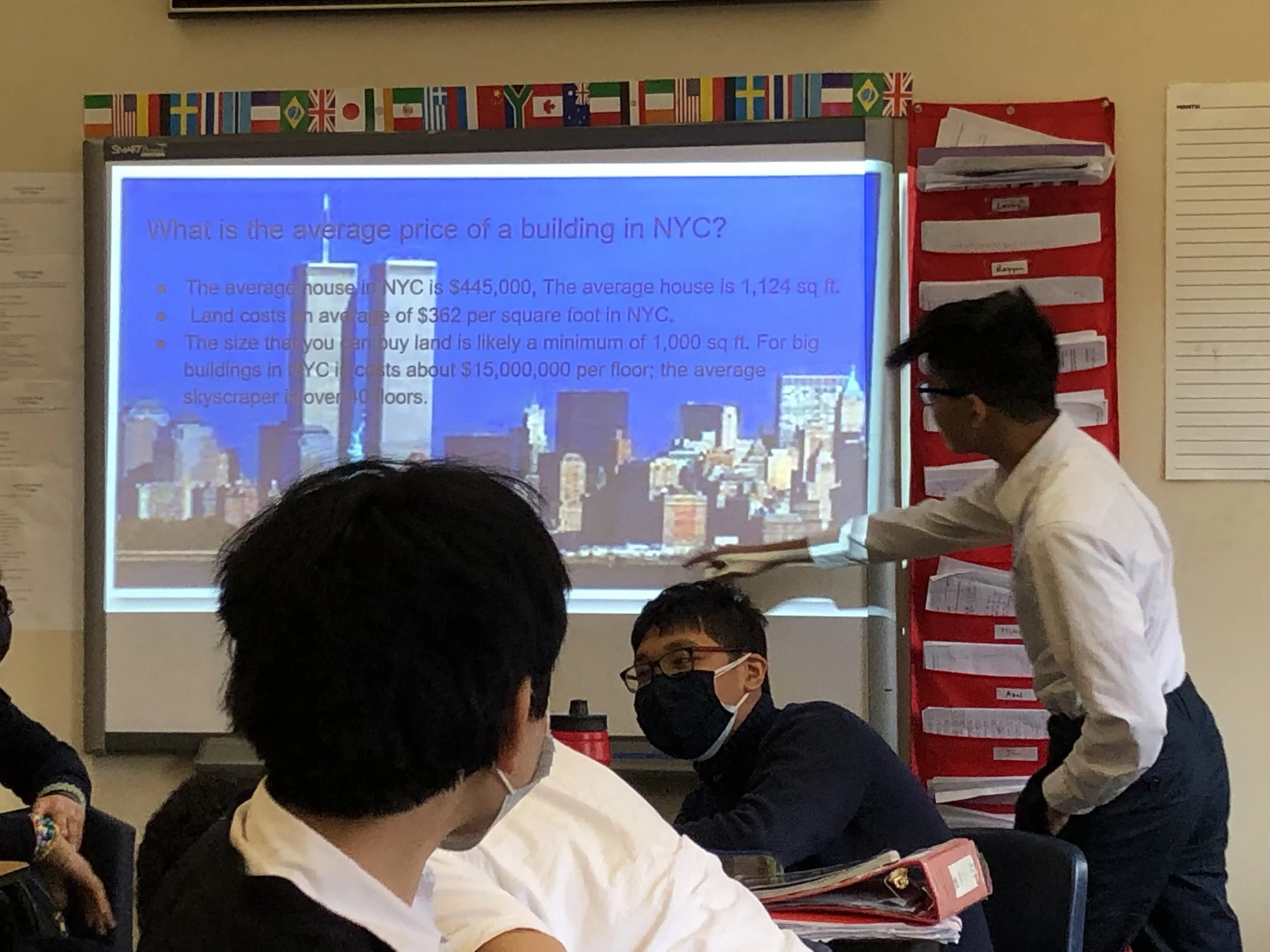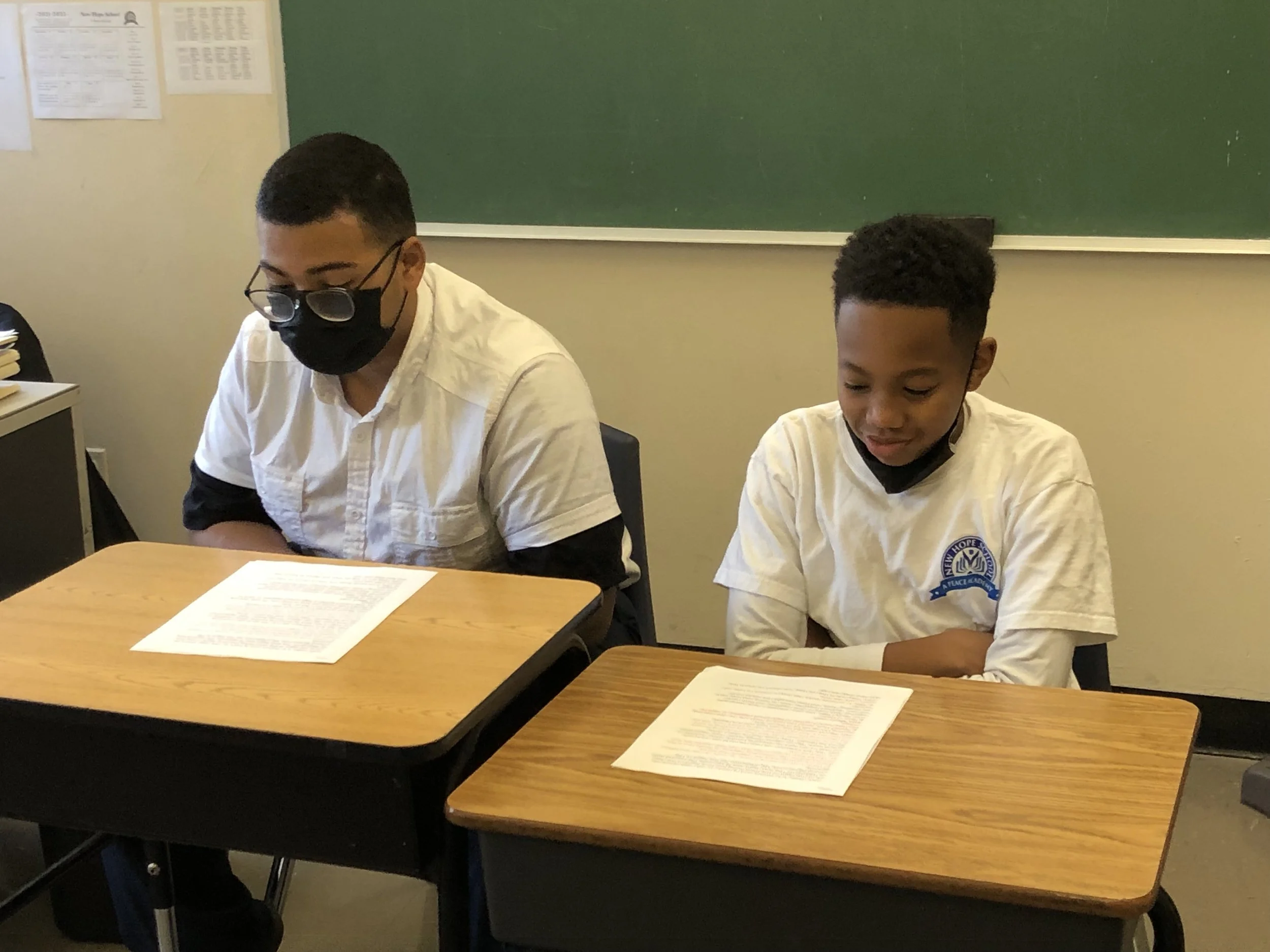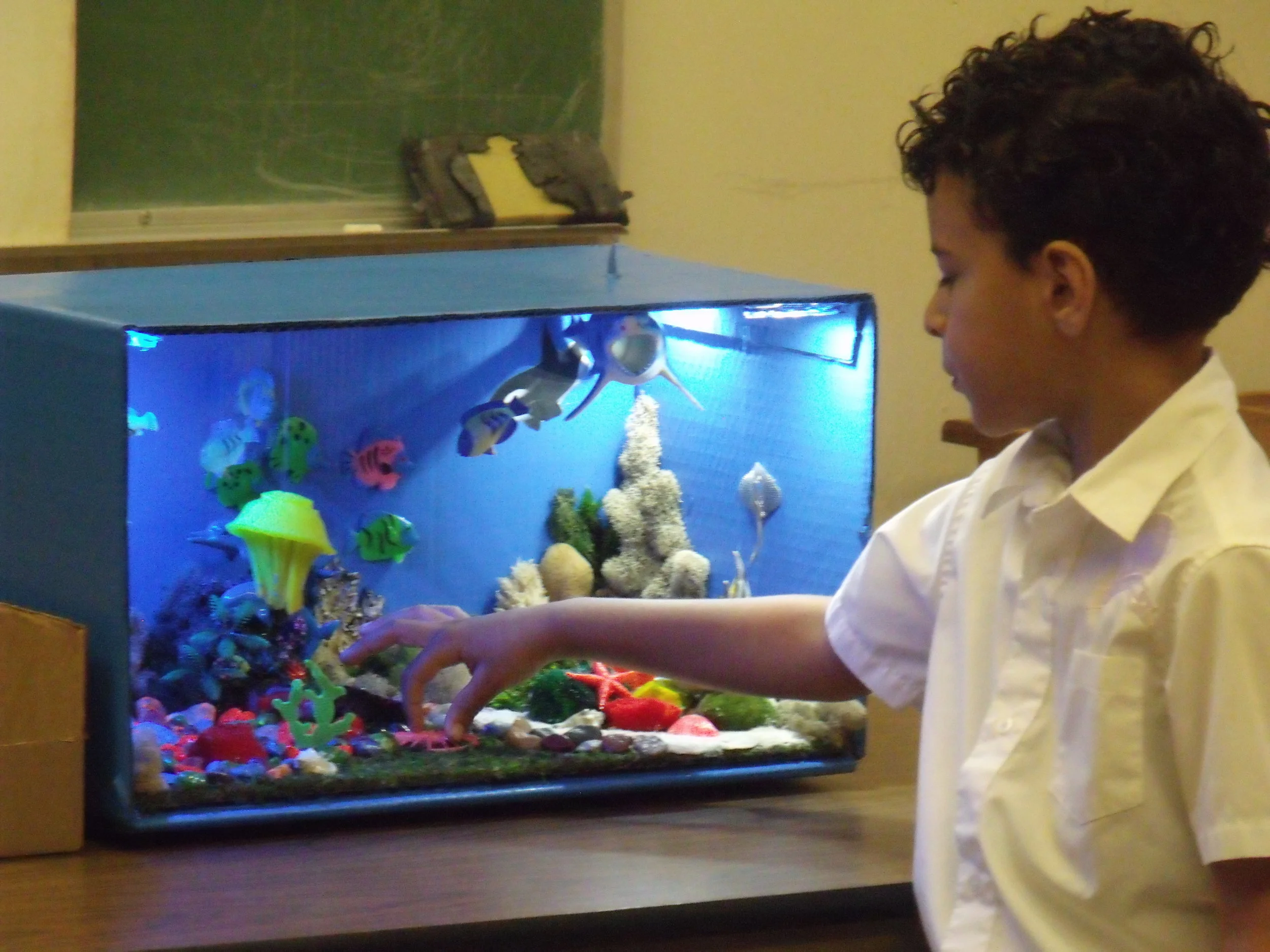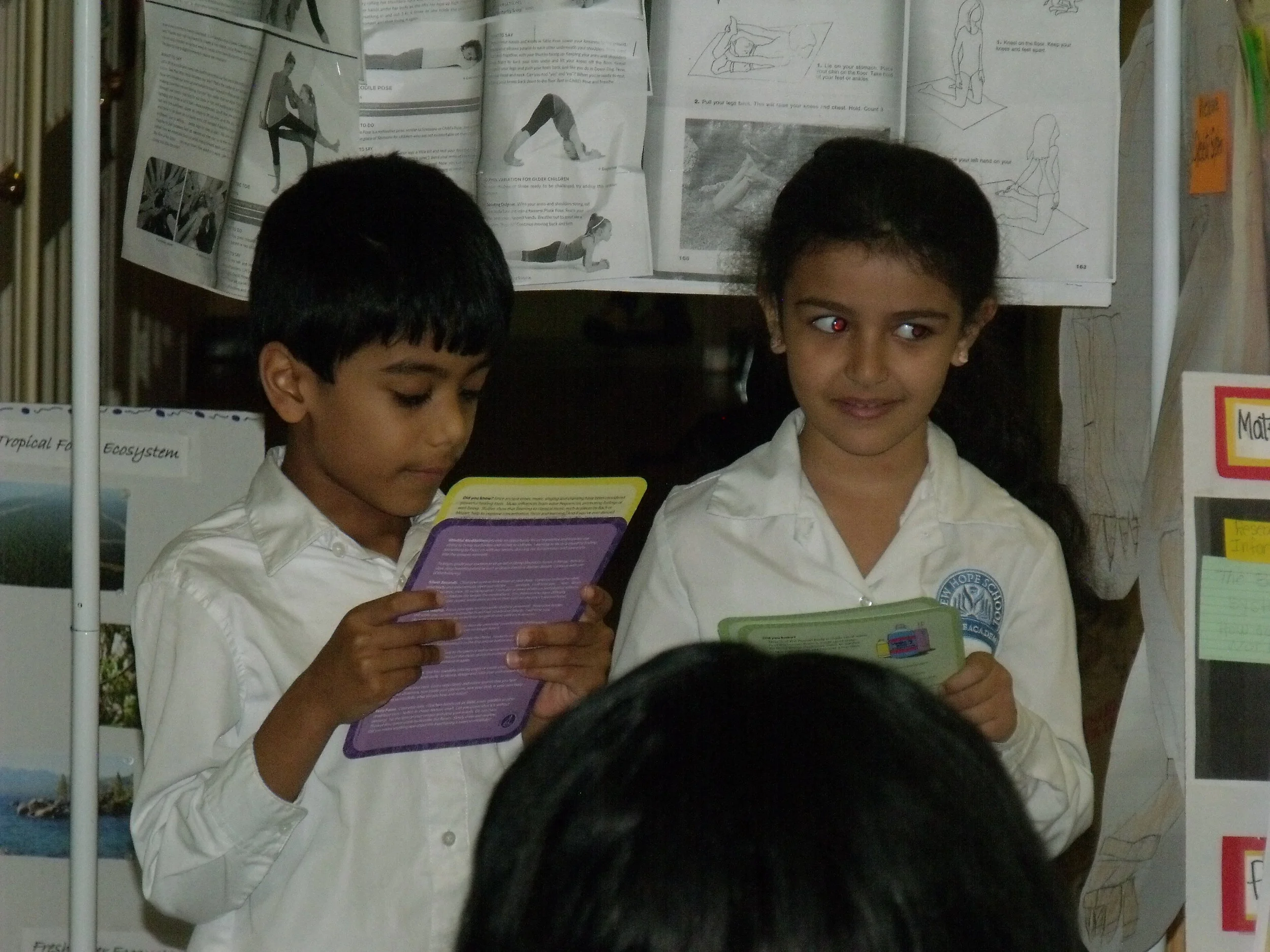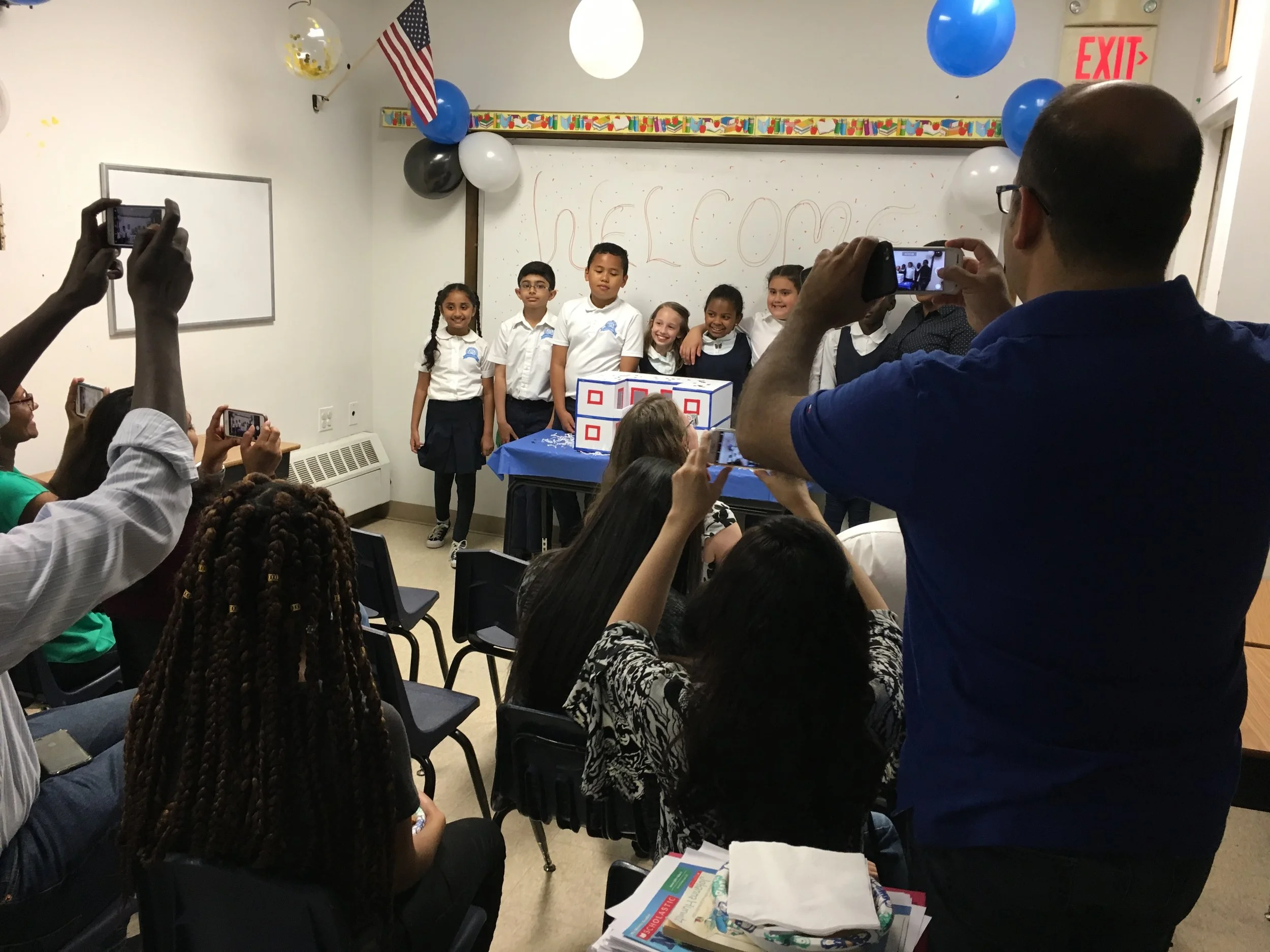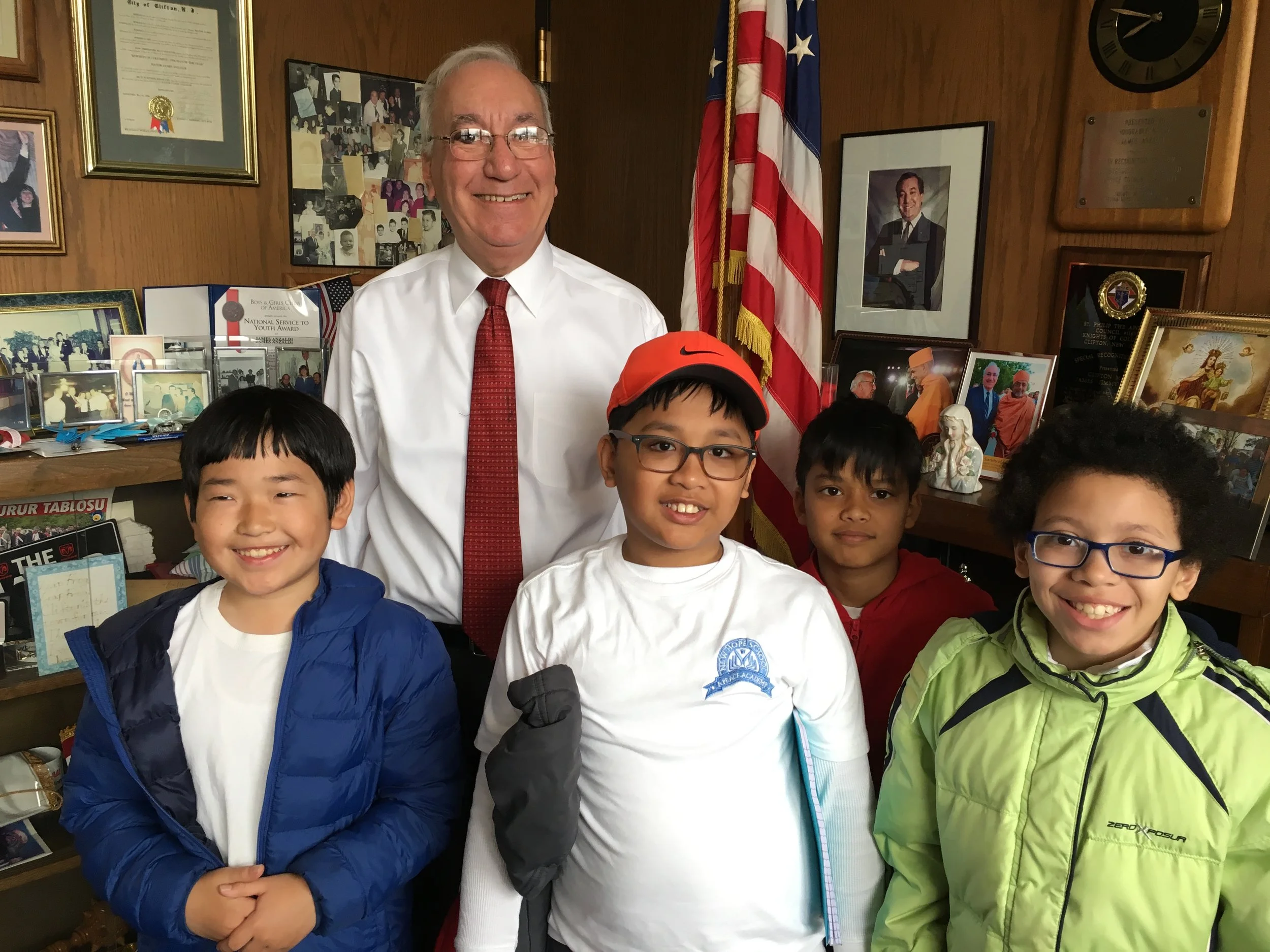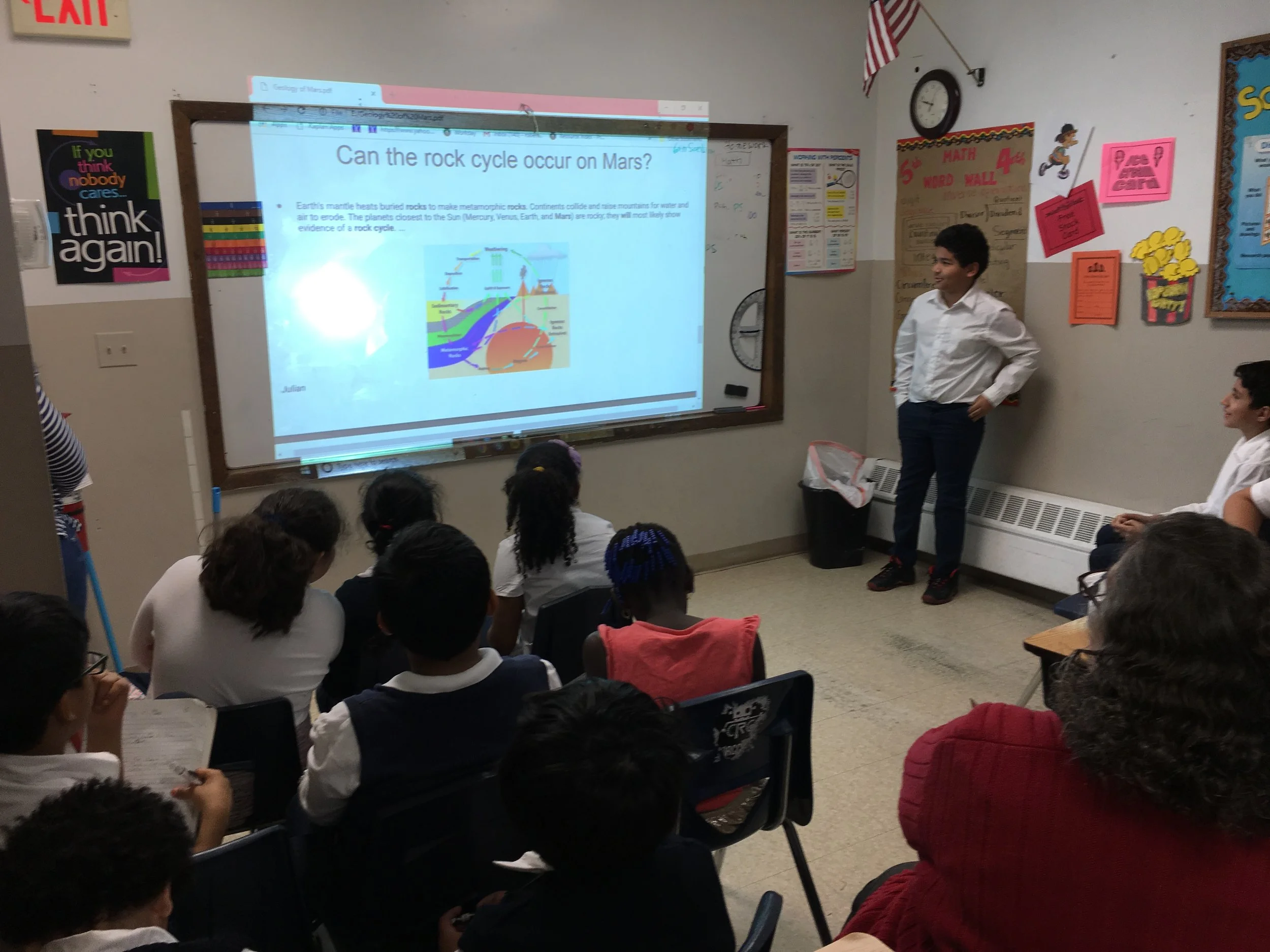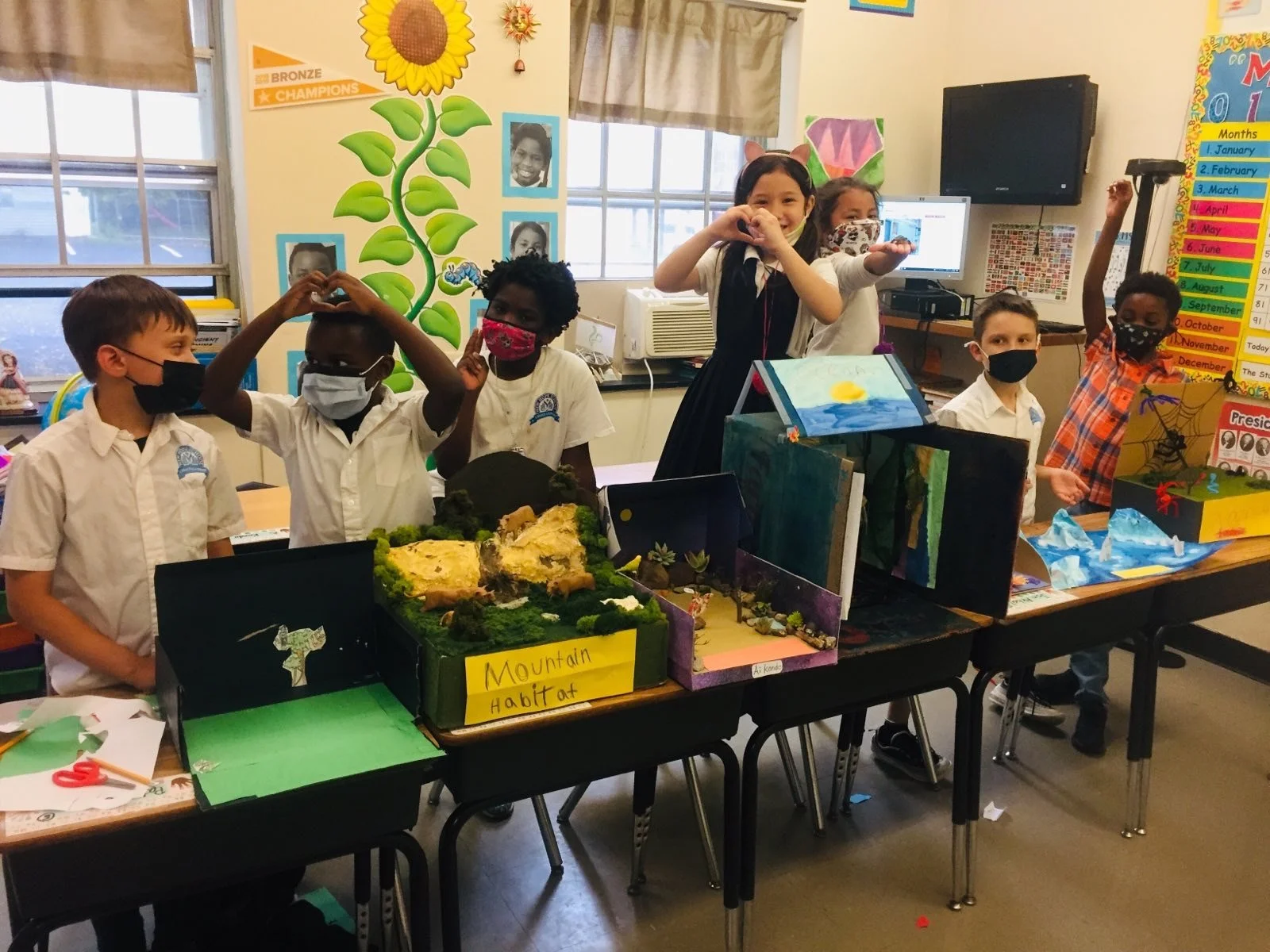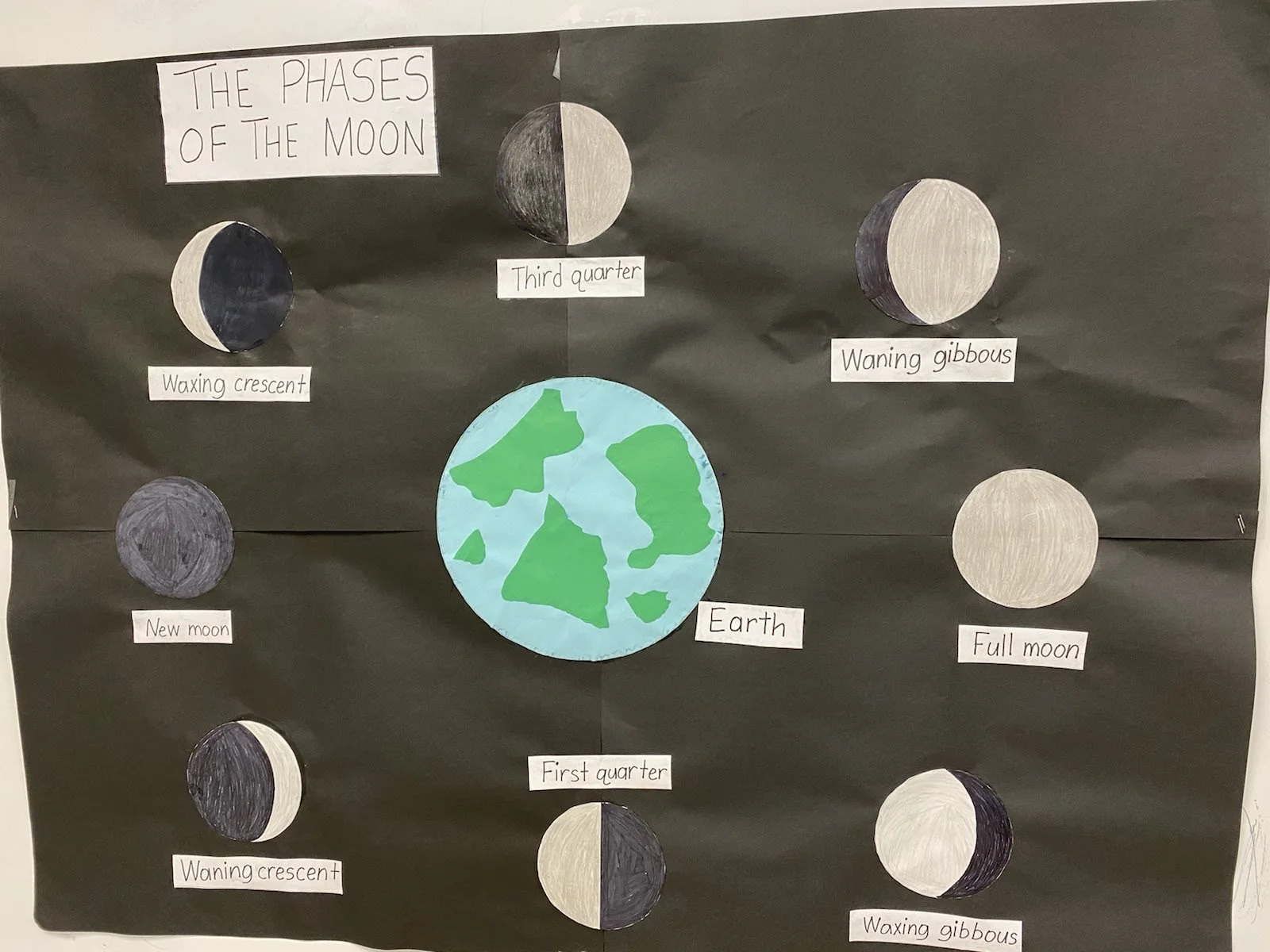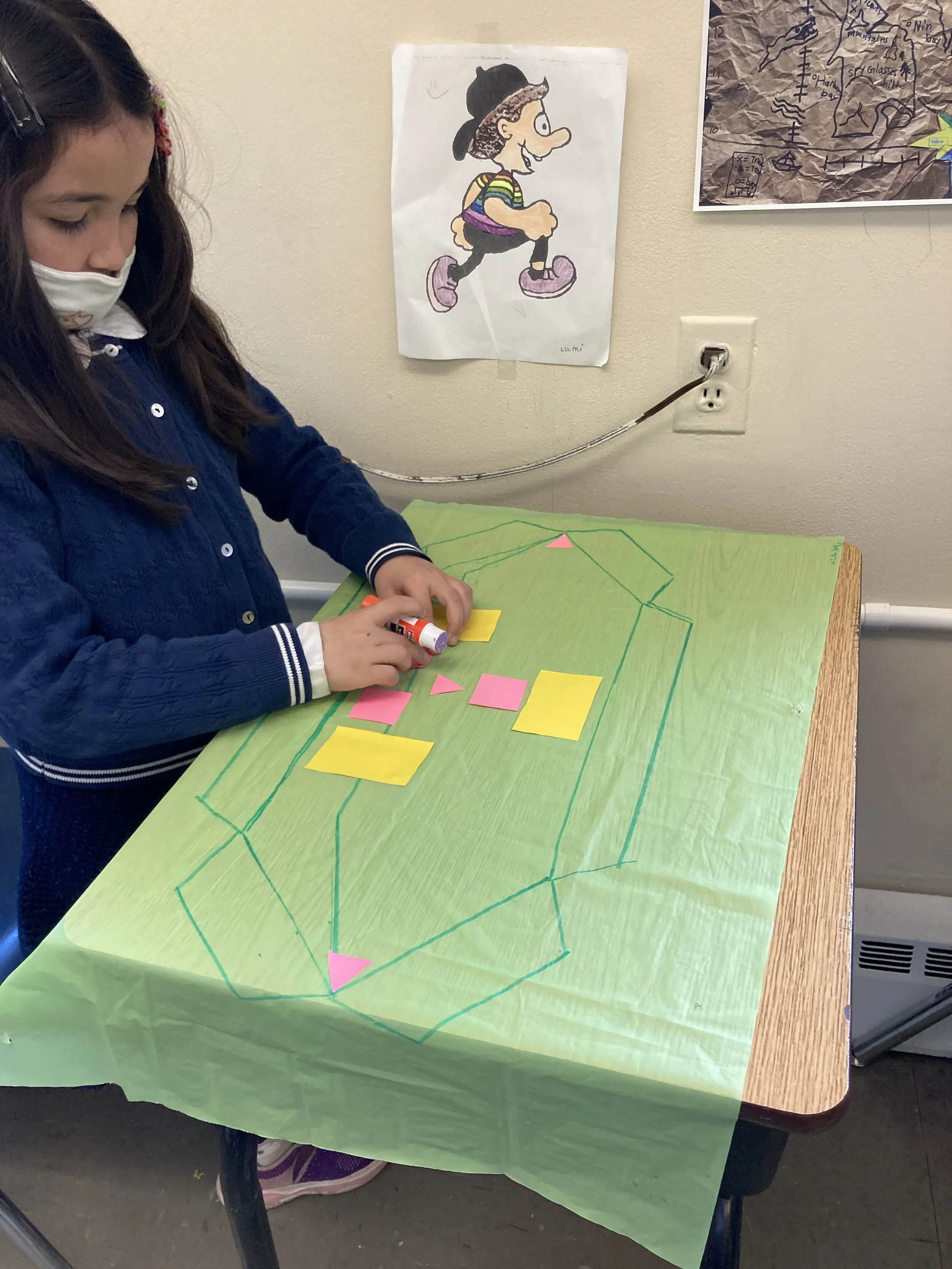New Hope School conducts a project-based learning component as part of its overall education program. Project-based learning focuses on teaching students key knowledge and understanding as well as success skills, such as critical thinking/problem solving, collaboration, and self-management.
A typical project is based on a meaningful problem to solve or question to answer, at an appropriate level of challenge for students, and is governed by an open-ended and engaging driving question.
The project involves an active, in-depth process over a period of several weeks, during which students generate their own questions, find and use resources, develop further questions, and come to conclusions.
There is a real-world context using real-world processes, tools, and standards. The project is connected to students’ own interests and identities and is expected to make a real-world impact.
Students are encouraged to choose the types of products they wish to create, how they will work and use their time, with guidance by their teacher.
Opportunities are provided for students to reflect on what and how they are learning as well as on the project’s design and implementation.
Students are expected to give and receive feedback on their work in order to revise their ideas and products or conduct further inquiry.
At the end, students demonstrate what they have learned by making a presentation beyond their own classroom, either to the entire school, their parents, or to the general community.
Past projects have included creating a 3D model of the Delaware Water Gap to understand its ecological significance and impact on the surrounding region; examining the physical geography of northeast New Jersey and its impact on the people living in the area; and creating a sales pitch to an imaginary tech company to convince its CEO to locate its new headquarters in a particular city.
2023-24 Projects
Country Project
Kindergarten
The Kindergarten Country Project is a captivating project-based learning initiative that encourages students to delve into the rich tapestry of global diversity. Each student embarks on a fascinating exploration by selecting a country of personal interest. Armed with creativity and curiosity, they construct a visually engaging tri-fold poster adorned with images depicting the country's national flag, food, sports, flower, animal, traditional clothes, notable figures, landmarks, and map. Culminating in a delightful International Food Festival, students bring in delectable snacks representing their chosen countries, fostering a delicious cultural exchange. Through taste tests and rating sessions documented in booklets, students not only savor global flavors but also engage in cross-cultural appreciation. The project concludes with a presentation, where students proudly showcase their completed posters to an esteemed guest, our principal Dr. Beebe, providing an opportunity for young minds to articulate newfound knowledge about the diverse aspects of their chosen nations. This immersive project not only promotes interdisciplinary learning but also instills a sense of cultural awareness and teamwork among the budding scholars
Puppet Show
First Grade
Using their creativity and imagination, students made puppets. With paper plates as masks, students created puppets on sticks as well as sock puppets to manipulate with their hands. Students gave their puppets personalities using buttons, yarn, and cloth stuck together with a glue gun. For a final presentation, students presented a skit about a pet dinosaur needing a home because of its problematic ways. The skit was viewed by the kindergarten, second grade, and parents and teachers.
This project aims to enhance students' knowledge of geographical features and map skills through research and presentations of their chosen country from the six continents: Asia, Africa, Oceania, Europe, North America, and South America. The students had to create a lapbook featuring a map of the country they chose, with the capital city, the major cities, landmarks, and landforms illustrated in the map key. It also highlighted important information about the country such as the culture, language, traditions, food, places, and animals.
Roman Empire Characters
Third Grade
Students transported their classmates through time with an engaging presentation on Ancient Rome Characters. Utilizing a Project-Based Learning approach, these students crafted visually appealing display boards featuring characters from Ancient Rome, cleverly integrating their own faces into the artwork. The dynamic presentation, where each student embodied their assigned character, captivated an audience ranging from 3rd to 8th graders. The success of the presentation was underscored by a lively Q&A session, showcasing the students' deep understanding and enthusiasm for the subject matter.
World Mountains
Fourth Grade
Students demonstrated their creativity and environmental consciousness through a hands-on project. Each student was tasked with creating a 3D model of a world mountain using recyclable materials. The students not only showcased their artistic skills but also presented their projects to an attentive audience spanning multiple grade levels. The interactive Q&A sessions that followed not only enriched the learning experience but also played a vital role in developing the students' confidence in public speaking, adding another layer to their educational journey.
Ancient Engineers-Roman Roads
Fifth & Sixth Grades
As a culmination of their unit on Ancient Greek and Roman Civilizations, students divided into two teams to develop plans for constructing a road during the Roman Empire from Rome to Germania. Students were asked to take into consideration the materials and tools available, the geographical terrain between Rome and Germania, specifically the presence of the Alps, and how that would affect construction of the road. One team constructed a model of the road using materials as close as possible to actual materials that would have been used and discussed the benefits of the road with the citizens of Germania; the other developed a PowerPoint presentation about the project that was presented to the Roman emperor, aka their teacher.
Odysseus’ Journey
Fifth & Sixth Grades
After reading the Odyssey, students in the 5/6 Language Arts class completed a multimedia project entitled “Odysseus’ Journey.” At the end of the Trojan War, the Greek hero, Odysseus, departs with his crew for his homeland of Ithaca. Odysseus had already been gone for ten years, fighting in the Trojan War. His journey home took an additional ten years. During this ten year trek, Odysseus and his crew visit many fantastic places throughout the Mediterranean Sea area. They face numerous challenges and battle various mythological creatures. “Odysseus’ Journey” details their journey and adventures by means of a large map, artwork depicting several stops on the journey, a diorama of the Cyclops cave, and a slide show. Through this project, students were able to learn about the geography of various real and mythological areas around the Mediterranean Sea. They could also more fully appreciate Odysseus’ character and determination to overcome all obstacles in order to return home.
Community Garden Coordinator
Fifth & Sixth Grades
To start, each student researched where community gardens exist in their towns and watched videos on community gardens. As community garden coordinators, their job was to organize the land they had available to rent out plots to individuals and/or provide a community public service with their garden. To do this, they learned to apply math skills and concepts, such as calculating area, scale units and conversion, and multiplication and division of mixed numbers, to a real-world situation, i.e., creating a community garden.
Buck’s Journey
Seventh & Eighth Grades
After reading The Call of the Wild by Jack London, the students in the 7th & 8th grade Language Arts class accomplished a multimedia project entitled “Buck’s Journey.”
Buck, a St. Bernard Scotch Shepherd dog, is the main character in this classic adventure book. After being kidnapped from his home in the Santa Clara Valley in CA, Buck is brought to Alaska. Buck is used as a sled dog during the Klondike Gold Rush period, and travels hundreds of miles through wilderness areas. “Buck’s Journey” details his trek by means of a large map, artwork depicting four key areas, a diorama of the camp by Stewart Creek, and a PowerPoint presentation. Through this project, students were able to learn about the geography of various remote areas and gain an appreciation of the vast distances covered by Buck on his travels.
Local Development Planner
Seventh & Eighth Grades
This project is designed to give students the opportunity to contact their city’s local planning department. In this way, they discover how the process for development occurs in Clifton and understand that city officials are personally accessible. Also, students discover the uses of mathematical concepts in real life. They created a bid proposal for a specific project, in this case the construction of a new parking lot for the city. Through this project, they learned about area and proportional reasoning. At the end, students presented their team’s bid to the “city council.”
2022-23 Projects
Forest & Plants
Kindergarten
The kindergarten learned all about plants and ecosystems, specifically in the context of temperate forests. The students were responsible for taking care of plants in class as well as working on building a diorama of a forest. They also learned about the various animals and their relationships with one another in a forest ecosystem.
Six Types of Energy
First Grade
We thought of this topic after learning about Benjamin Franklin as an inventor and his interest in lightening as energy. The energy of static electricity and the conservation of wood by saving of heat with his invention of the stove. Each student was given an energy source and researched its historical uses, both pro and con. We grouped each energy source according to its history, use, cost, reliability, and safety. Questions considered were: What other energy sources might be developed? What would be their cost and availability? What environmental concerns are there? Students’ findings will be presented in a mural to hang on the wall.
States of Matter
Second Grade
This project aimed to help children identify the three states of matter and understand the conditions that change states of matter, such as heating, cooling, and applying force (pushes and pulls). The children also named, compared, and contrasted the properties of matter as they changed states. The class presented their findings at a school assembly.
Water Cycle
Third & Fourth Grades
The water cycle was chosen a class project to educate students of how important water is to the universe because there is only 3% of fresh water and 97% of salt water. The water cycle is extremely important because it enables the availability of water for all living organisms and regulates weather patterns on our planet. Students made a 3D model to understand the process of how water recycles naturally to always provide clean water. They offered a presentation at the monthly school assembly.
Shipwreck
Fifth & Sixth Grades
Students play the role treasure hunters who have discovered an old shipwreck off the coast of Florida. In the first exploration of the site, divers found many coins. These coins were examined and the students were required to figure out where they came from and why they were on that ship. What they found would decide whether or not investors would agree to fund a more involved trip to bring the shipwreck contents to the surface. Students divided up into teams and created a photo story of the coins, a research report, a brochure about the shipwreck site, and a proposal to investors to fund further dives to the site. The teams presented these to the rest of the class.
The Space Race
Seventh & Eighth Grades
As part of a unit on the Cold War, students were tasked is to create PowerPoint presentations for people interested in learning about the space race during the 1950s, 1960s, and 1970s. Their presentations were to provide narratives explaining the space race and how it got started. They were to include evidence to support their narratives and the claims they made. They were asked to utilize original articles, videos, diagrams, and other primary sources in creating their presentations. Topics covered the first artificial satellites, the Mercury and Apollo programs, the creation of the International Space Station, the space shuttle, and New Horizon program.
2021-22 Projects
Class President Election
Kindergarten
All 8 students participated in a class election. They created signs, chose a slogan, and created a campaign to get others to vote for them. They presented their project to the 2nd, 3rd, and 4th grade classes who voted for their favorite candidate. The kindergarten children also got to vote and therefore experienced both being a candidate and voting themselves.
Creating a Sanctuary Through Literature
First Grade
From stories we have read in class, fiction to nonfiction, biography to fantasy, through reading we find understanding and calm. We find what we like and what we need and finally what makes us feel good. From there each student created a storybook, both writing and illustrating it. Students hopefully will remember the process to use to help with problem solving. Also, to become more confident, happy, and healthy by having created a sanctuary through literature with all its benefits.
Treasure Map
Second & Third Grades
Students created their own island and treasure map. This project aimed to capture the interests of students while assessing what they have learned about maps. In this project students picked out a pirate name, designed and named their own island. They also got to name their oceans, place landmarks and landforms on their island. Then, they each made a map with a compass rose and map key and used directionality to give directions to their treasures. Through to the completion of the project, they were expected to apply basic map skills and presented their finished product. The project concluded with students searching for an actual treasure/time capsule which was buried in the playground by students in 2015 using a map created by the school principal.
Energy Transformation
Fourth Grade
Students learned about the relationship between energy and change. They observed the difference forms such as sound, light, thermal energy (heat), and electrical energy. These forms of energy can cause a change, such as when heat melts butter. They learned that one form of energy can transform (convert) into another, as in potential energy into kinetic energy by kicking a stationary ball.
“Journey to the Center of the Earth” Travel Brochures
Fifth & Sixth Grades
Students demonstrated their knowledge of the layers of the Earth by making a travel brochure to the center of the Earth. This travel brochure included the vehicle they will be taking, accommodations, information about the layers, diagrams, etc. Students needed to conduct independent research on materials the vehicle should be made of, things they might encounter on their journey, etc.
Ancient Engineers: Roman Roads
Fifth & Sixth Grades
Students researched and made a plan to build a road during the time of the Roman Empire linking Rome to a province in Germania. They had to take into consideration the materials, tools, and labor available, the precise route of the project, the challenges to building the road along the way, and the overall cost. They were asked also to consider the benefits to the Empire of building the road and whether they outweighed the costs. Finally, student partners presented their ideas to the Roman emperor for his approval.
City for Sale
Seventh & Eighth Grades
Students wrote a report and created a slide presentation to pitch a city of their choosing to a fictitious IT CEO who was looking to relocate his headquarters. Students were asked to think about what features would attract the CEO to their city, e.g., employment situation, housing, cost-of-living, restaurants, entertainment attractions, sports, etc. They were challenged to develop a persuasive argument during their presentation to convince the CEO to choose their city.
Wright Brothers & First Flight
Seventh & Eighth Grades
Students researched the factors contributing to the first successful manned flight by Orville and Wilbur Wright in 1903. What were the obstacles they had to overcome in order to get their plane into the air, be able to maintain control over the aircraft, and ultimately land it safely? Why did they decide to conduct the first flight at Kitty Hawk, North Carolina? Why did they decide to do so in the cold of December? At the end, students presented a mock radio broadcast as an eyewitness to this historic event. They also wrote a newspaper article recounting the event.
2019-20 Projects
Ecosystems in Real Life
Kindergarten
Students researched and created dioramas of various kinds of ecosystems illustrating the types of vegetation and animals that live there. Students learned how their ecosystems support these life forms. Their products were presented as part of our science fair in May.
My Body, My Life
First Grade
Students researched and reconstructed on a model of the human body six major systems of the body: digestive, respiratory, circulatory, skeletal, muscular, and nervous. They learned the connectedness of these systems and the link between the physical body, exercise, and diet. They also examined the effect of their emotions on their physical well-being. Students presented their discoveries at the science fair in May.
Water Pollution
Second Grade
Students examined the impact of water pollution on our school, city, country, and the world. They investigated how pollutants enter the water cycle and the damage its causes. Working as a group, they discussed, reflected, and decided the best ways to purify water. Using their knowledge of the water cycle, students created terrariums, wrote reports, and presented their findings at a school assembly in June.
Designing a School
Third Grade
Working as a group, students designed the ideal school, taking into consideration its overall purpose, function of the different sections, the school day schedule, the types of classes held, technology, efficiency, and budgeting. They considered the types of materials to be used and presented the finished product to an enthusiastic audience—their parents—in their classroom.
Marking History, Making History
Fourth & Fifth Grades
Starting with an interview with Clifton Mayor James Anzaldi, students researched and wrote about the history of the Clifton area from the perspectives of Native Americans, African-Americans, early English settlers, and later immigrants. They came to understand that there is more than just one history of a given area depending on one’s perspective. Presentations were made at a school assembly on May 3 focusing on four main areas: Morris Canal, Clifton’s farms, the former quarantine station, and Garret Mountain.
Rocking the Rock Cycle on Mars
Sixth & Eighth Grades
Why is Mars so different from Earth? Students compared the two planets seeking to understand the conditions necessary to support the generation of life. Their investigation included geological structure, the water cycle, the formation of an atmosphere, and the generation of weather. The project concluded with students giving PowerPoint presentations to younger students in April.
2020-21 Projects
The Planets of Our Solar System
Kindergarten
Students learned facts about the planets of our solar system. They identified how far each planet is from the sun as well as its order in the solar system. They learned the weather patterns and characteristics of each planet and made a presentation in a class level science fair to their fellow students as well as first graders. In addition, students created art crafts, planet chalk art, playdough models, and sang songs about the planets.
Food Truck
First Grade
Students made cardboard food trucks while learning what is necessary for a successful business, including equipment needed, advertising, food menu, and health regulations. They learned how to make delicious food, set prices, display the food, the importance of good work habits, keeping a helpful and happy attitude towards customers and fellow workers, and developing problem solving skills. They also learned the basics of balancing income and expenses to make a profit. At the end, students set up four mock food trucks in the playground where they “sold” their food products to students from other grades.
Animal Adaptations
Second Grade
Animal adaptations are the important changes in physical and behavioral characteristics of animals that have developed and occurred over a period of time which allow them to live and survive in their environments. An environment is the surroundings and conditions in which we live with plants and animals. As changes occurred in the environment we live, plants and animals, including us, learn to adapt to survive. In this project, students learned how different animals around the world adapt to the changing conditions of the habitat they lived in. They were expected to do research about the habitat they chose, write a journal, create a diorama, and present it to the class.
How Earth & Moon Interact
Third Grade
Working as a group, students made a physical model and poster demonstrating the eight phases of the moon and how the moon interacts with the earth. Through the eight phases, students could understand how the moon revolves around the earth once every 29 1/2 days to complete one phase cycle from new moon to new moon. They then presented their findings to their fellow students and parents.
Let’s Go Fly a Kite
Fourth & Fifth Grades
Students measured line segments and angles to help design a kite pattern. They each constructed a large kite pattern given a scale. They drew polygons from given dimensions and decorated their kite symmetrically. Finally, they had an opportunity to use their pattern to make a kite. We had a Kite Festival at the end of our annual Race for Education where students showcased their completed designs to the school community.
Assembly Lines
Sixth, Seventh & Eighth Grades
On the foundation of their unit on the Industrial Revolution, students learned about the development of the assembly line as a way to efficiently, economically, and quickly produce large amounts of products to meet the growing demand for consumer goods by the American population. Students each created a prototype of a product of their invention, drew a design for an assembly line to build the product, wrote a training manual for workers involved in the production, and demonstrated how their assembly line would work in a mock up.
